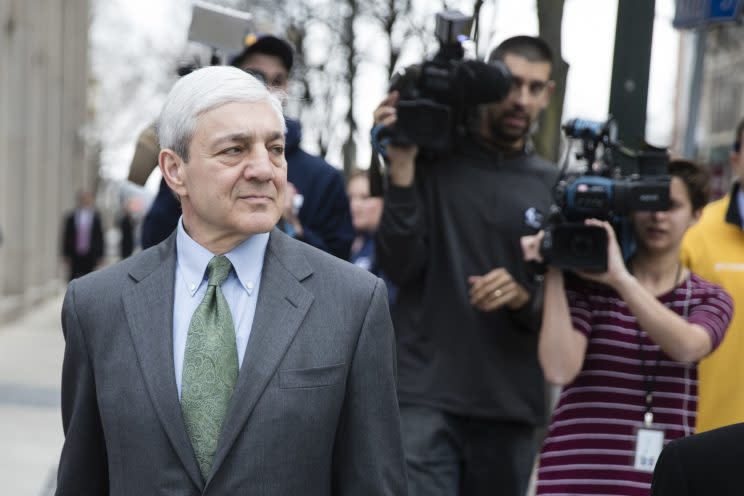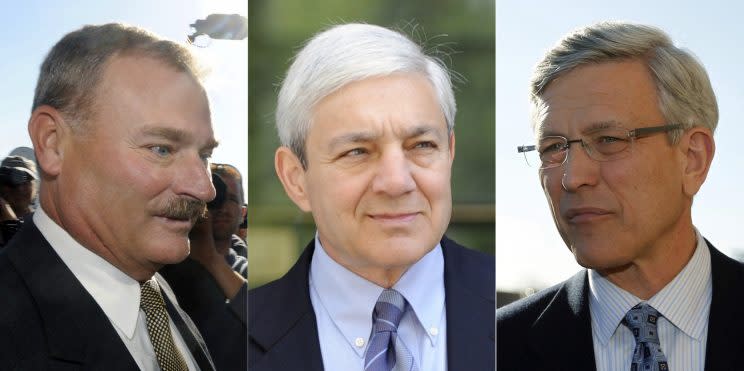Why ex-Penn State president Graham Spanier deserves to go to prison
Even his supporters across higher education always acknowledged former Penn State president Graham Spanier operated with a significant amount of father-knows-best arrogance. He was, they’d say, convinced he was the smartest man in the room.
It’s part of what got him to Friday afternoon in Dauphin County (Pa.) court, his fate and freedom resting in a jury’s hands. First it allowed him to ascend to Penn State’s presidency for 16 years. Then it contributed to finding himself charged with failing to report the horrific crimes of Jerry Sandusky in the face of massive concerns.
And finally, in being found guilty of endangering the welfare of children, a charge that carries a sentence of up to five years in prison, for the now 68-year-old administrator. Sentencing will take place late this spring in Harrisburg.
Spanier was found guilty after his defense offered no defense in his case, calling no witnesses, let alone Spanier himself. It foolishly believed the jury would agree with them that state prosecutors hadn’t proven what was a challenging case. That he was found not guilty on a separate conspiracy charge is a moral victory that will ring hollow if he ends up behind bars, where he would be known as Jerry Sandusky’s protector.
That Spanier misread the mood of the jury and placed too much belief in others’ ability to see the intricacies of his defense pretty much says it all.
Two of his co-defendants, former athletic director Tim Curley and former vice president Gary Shultz, wisely took plea deals last week, admitting guilt on endangerment charges. As such, they will likely receive only house arrest at most. They, too, will be sentenced at a later date.
Spanier decided to fight. Only not with everything he had.

The case was complicated. For instance, the endangerment conviction stems from an incident when Sandusky was a former employee, a retired defensive coordinator, not a current one. Was Spanier really responsible for anyone who stepped on Penn State’s expansive campuses across the Commonwealth?
The fact the state was willing to offer leniency to Curley and Shultz, who clearly had more direct culpability than Spanier, suggested how much prosecutors needed their testimony to win.
The sad and sordid Sandusky scandal has always been about the broad strokes though, even though many Penn State supporters have argued through the weeds, parsing this phrase and picking apart that testimony.
For most, this was a terrible story that boiled down to one simple question: Why didn’t officials at Penn State stop Sandusky’s reign of terror when they had the chance?
Namely, in 2001, when Mike McQueary, a then-graduate assistant, reported seeing Sandusky alone with a boy in the showers of an otherwise empty locker room late on a Friday night.
That would be a jarring, alarming, beyond troubling allegation. There would be no reason for him to be there with a child.
Yet this was even worse. It came less than three years after Sandusky had narrowly avoided prosecution from a similar incident.
In 1998, an 11-year-old boy came home after going to the Penn State weight room with Sandusky. His mother noticed his hair was wet and asked why. The boy said he and Sandusky had showered together, an act that included Sandusky lathering him up with soap and bear hugging him from behind as he lifted the boy up closer to the shower head. Mom called the cops.
Sandusky wept to police when questioned. He claimed it was all an innocent act, a misunderstanding, a mistake. He wasn’t charged because the local district attorney, much to the forever frustration of the lead detective, felt it would be a challenging case to gain a conviction. Sandusky escaped.
If – IF – that was somehow, someway an explainable act and if – IF – Sandusky somehow, someway wasn’t a despicable deviant using his fame from Joe Paterno’s football program and his position with the Second Mile charity to lure the most vulnerable and exploitable kids to him, then Sandusky would never put himself in such a compromised position again.
An innocent man might stop being with kids altogether. Or maybe limit mentoring to large groups in public places. They’d only shower at home. They wouldn’t risk anything. They certainly would never, ever shower alone with another boy in what they assumed would be an empty locker room in the bowels of an otherwise empty facility after hours – if only to guard against false accusations.
That the 1998 investigation ended without charges limited what an administrator or anyone else could really do at the time. The proper authorities looked into it and made a determination. That’s the system. It failed, but at least it was used. You might proceed with heightened vigilance against Sandusky, but there is only so much that could be done.
However, anyone in 2001, armed with the knowledge of 1998, couldn’t possibly hear about the new accusations and then act with anything less than complete and immediate outrage. The second time couldn’t be innocent. The second act couldn’t be explainable. The second act was a burning red flag atop Mount Nittany.
So the question always was, in 2001, did Graham Spanier know about 1998? Did Tim Curley? Did Gary Schultz? Did Joe Paterno?
And this trial, the Spanier trial, finally answered that.

Yes, Graham Spanier knew about 1998, according to Curley’s testimony. Yes, Curley knew about 1998. Yes, Gary Schultz knew about 1998. And yes, again because of Curley’s testimony, the late Joe Paterno knew about 1998.
And yet, collectively they acted like they hadn’t.
This case was no longer an issue about what was precisely conveyed in the game of telephone that occurred after McQueary first went to Paterno with details of what he saw. Was it “extremely sexual” or was it just “horseplay” or was it … who cares?
Jerry Sandusky was back in the showers, a shower late on a Friday night, all by his naked self with another naked boy.
That was enough. Or should have been.
This called for the police. This called for child services. This called for the district attorney. This called for immediately bringing in McQueary and asking more questions (instead it took Curley and Shultz 10 days to have a meeting). This called for an immediate hunt for the boy (no one ever went searching).
This called for experts and profound action. Instead, Spanier agreed to a plan telling Sandusky not to bring kids on campus anymore and merely reporting the incident to Second Mile. In an email, Spanier reasoned it would be “more humane” that way.
Yeah, more humane for Sandusky. Certainly not for the children of Centre County.
Somehow, someway, Penn State did less in 2001 than what occurred in 1998. That’s, of course, because originally the boy’s mother went directly to the police. This time a graduate assistant went up the bureaucratic chain of command.
As a result, Sandusky roamed free for another decade, continuing to abuse who knows how many additional young men. The whole thing was sick and sorry, pathetic and painful.
Spanier tried to test a jury in a state still angry and obsessed by the Sandusky scandal. To survive he’d need to reverse an extensive losing streak that has seen the state/whistleblowers win in criminal and civil courts with decisions by jurors and judges.
And then he tried to get cute and just argue the state didn’t present their case, never accounting for his inaction. For the hardcore Penn State fan, details like Curley saying Joe Paterno never tried to lobby for leniency on Sandusky (which runs contrary to the conclusion of the Freeh Report) might matter.
In a broader world it is just white noise, nothing compared to the violence of Sandusky and the single question at hand.
Sandusky needed to be stopped. Sandusky should have been stopped. You can’t know about 1998 and act like these guys did in 2001, talking themselves into a bad idea, clueless and callous to the impact they would have.
All of them – Spanier, Shultz, Curley and Paterno – fancied themselves as great leaders, as role models, as decision-makers. They were paid great sums of money to be just that. They failed here. Failed at the worst possible time.
“They took a gamble,” Laura Ditka, the chief deputy attorney general, said in closing arguments. “But they weren’t playing with dice; they were playing with kids[‘ lives].”
With punishments looming and pleas made, perhaps now Spanier et al will finally admit how wrong they were all along.
More on Yahoo Sports:
• Shaquille O’Neal isn’t a flat-Earther after all
• Horrendous final possession dooms West Virginia in NCAA tourney
• Jeff Passan: Meet the man fighting MLB’s silliest stigma
• Massive drug bust has unlikely tie to Lionel Messi

